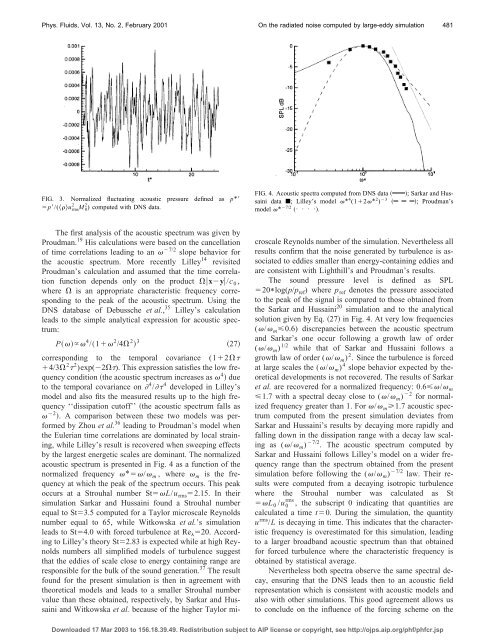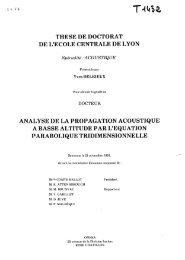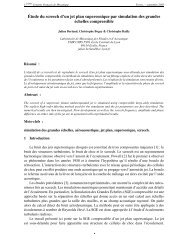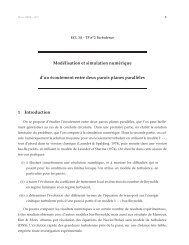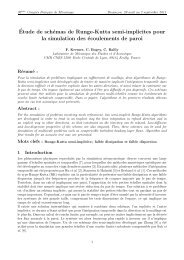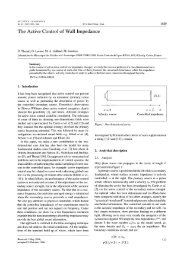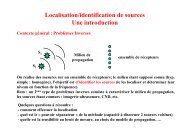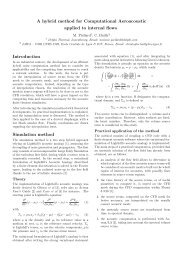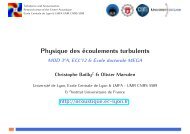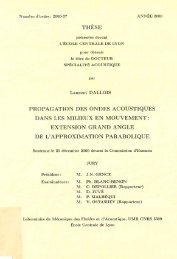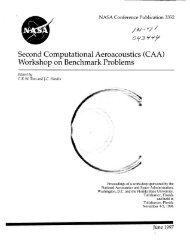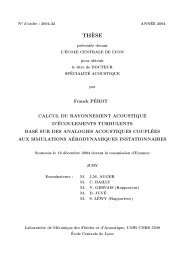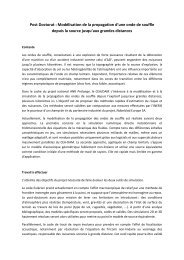On the radiated noise computed by large-eddy simulation
On the radiated noise computed by large-eddy simulation
On the radiated noise computed by large-eddy simulation
Create successful ePaper yourself
Turn your PDF publications into a flip-book with our unique Google optimized e-Paper software.
Phys. Fluids, Vol. 13, No. 2, February 2001 <strong>On</strong> <strong>the</strong> <strong>radiated</strong> <strong>noise</strong> <strong>computed</strong> <strong>by</strong> <strong>large</strong>-<strong>eddy</strong> <strong>simulation</strong><br />
FIG. 3. Normalized fluctuating acoustic pressure defined as p*<br />
2 2<br />
p/(u rmsM<br />
0) <strong>computed</strong> with DNS data.<br />
The first analysis of <strong>the</strong> acoustic spectrum was given <strong>by</strong><br />
Proudman. 19 His calculations were based on <strong>the</strong> cancellation<br />
of time correlations leading to an 7/2 slope behavior for<br />
<strong>the</strong> acoustic spectrum. More recently Lilley 14<br />
revisited<br />
Proudman’s calculation and assumed that <strong>the</strong> time correlation<br />
function depends only on <strong>the</strong> product xy/c 0 ,<br />
where is an appropriate characteristic frequency corresponding<br />
to <strong>the</strong> peak of <strong>the</strong> acoustic spectrum. Using <strong>the</strong><br />
DNS database of Debussche et al., 35 Lilley’s calculation<br />
leads to <strong>the</strong> simple analytical expression for acoustic spectrum:<br />
P 4 /1 2 /42 3 27<br />
corresponding to <strong>the</strong> temporal covariance (12<br />
4/3 2 2 )exp(2). This expression satisfies <strong>the</strong> low frequency<br />
condition <strong>the</strong> acoustic spectrum increases as 4 due<br />
to <strong>the</strong> temporal covariance on 4 / 4 developed in Lilley’s<br />
model and also fits <strong>the</strong> measured results up to <strong>the</strong> high frequency<br />
‘‘dissipation cutoff’’ <strong>the</strong> acoustic spectrum falls as<br />
2 . A comparison between <strong>the</strong>se two models was performed<br />
<strong>by</strong> Zhou et al. 36 leading to Proudman’s model when<br />
<strong>the</strong> Eulerian time correlations are dominated <strong>by</strong> local straining,<br />
while Lilley’s result is recovered when sweeping effects<br />
<strong>by</strong> <strong>the</strong> <strong>large</strong>st energetic scales are dominant. The normalized<br />
acoustic spectrum is presented in Fig. 4 as a function of <strong>the</strong><br />
normalized frequency */ m , where m is <strong>the</strong> frequency<br />
at which <strong>the</strong> peak of <strong>the</strong> spectrum occurs. This peak<br />
occurs at a Strouhal number StL/u rms2.15. In <strong>the</strong>ir<br />
<strong>simulation</strong> Sarkar and Hussaini found a Strouhal number<br />
equal to St3.5 <strong>computed</strong> for a Taylor microscale Reynolds<br />
number equal to 65, while Witkowska et al.’s <strong>simulation</strong><br />
leads to St4.0 with forced turbulence at Re 20. According<br />
to Lilley’s <strong>the</strong>ory St2.83 is expected while at high Reynolds<br />
numbers all simplified models of turbulence suggest<br />
that <strong>the</strong> eddies of scale close to energy containing range are<br />
responsible for <strong>the</strong> bulk of <strong>the</strong> sound generation. 37 The result<br />
found for <strong>the</strong> present <strong>simulation</strong> is <strong>the</strong>n in agreement with<br />
<strong>the</strong>oretical models and leads to a smaller Strouhal number<br />
value than <strong>the</strong>se obtained, respectively, <strong>by</strong> Sarkar and Hussaini<br />
and Witkowska et al. because of <strong>the</strong> higher Taylor mi-<br />
481<br />
FIG. 4. Acoustic spectra <strong>computed</strong> from DNS data ; Sarkar and Hussaini<br />
data ; Lilley’s model * 4 (12* 2 ) 3 ; Proudman’s<br />
model * 7/2 ••••.<br />
croscale Reynolds number of <strong>the</strong> <strong>simulation</strong>. Never<strong>the</strong>less all<br />
results confirm that <strong>the</strong> <strong>noise</strong> generated <strong>by</strong> turbulence is associated<br />
to eddies smaller than energy-containing eddies and<br />
are consistent with Lighthill’s and Proudman’s results.<br />
The sound pressure level is defined as SPL<br />
20*log(p/p ref) where p ref denotes <strong>the</strong> pressure associated<br />
to <strong>the</strong> peak of <strong>the</strong> signal is compared to those obtained from<br />
<strong>the</strong> Sarkar and Hussaini 20 <strong>simulation</strong> and to <strong>the</strong> analytical<br />
solution given <strong>by</strong> Eq. 27 in Fig. 4. At very low frequencies<br />
(/ m0.6) discrepancies between <strong>the</strong> acoustic spectrum<br />
and Sarkar’s one occur following a growth law of order<br />
(/ m) 1/2 while that of Sarkar and Hussaini follows a<br />
growth law of order (/ m) 2 . Since <strong>the</strong> turbulence is forced<br />
at <strong>large</strong> scales <strong>the</strong> (/ m) 4 slope behavior expected <strong>by</strong> <strong>the</strong>oretical<br />
developments is not recovered. The results of Sarkar<br />
et al. are recovered for a normalized frequency: 0.6/ m<br />
1.7 with a spectral decay close to (/ m) 2 for normalized<br />
frequency greater than 1. For / m1.7 acoustic spectrum<br />
<strong>computed</strong> from <strong>the</strong> present <strong>simulation</strong> deviates from<br />
Sarkar and Hussaini’s results <strong>by</strong> decaying more rapidly and<br />
falling down in <strong>the</strong> dissipation range with a decay law scaling<br />
as (/ m) 7/2 . The acoustic spectrum <strong>computed</strong> <strong>by</strong><br />
Sarkar and Hussaini follows Lilley’s model on a wider frequency<br />
range than <strong>the</strong> spectrum obtained from <strong>the</strong> present<br />
<strong>simulation</strong> before following <strong>the</strong> (/ m) 7/2 law. Their results<br />
were <strong>computed</strong> from a decaying isotropic turbulence<br />
where <strong>the</strong> Strouhal number was calculated as St<br />
L 0 /u 0 rms , <strong>the</strong> subscript 0 indicating that quantities are<br />
calculated a time t0. During <strong>the</strong> <strong>simulation</strong>, <strong>the</strong> quantity<br />
u rms /L is decaying in time. This indicates that <strong>the</strong> characteristic<br />
frequency is overestimated for this <strong>simulation</strong>, leading<br />
to a <strong>large</strong>r broadband acoustic spectrum than that obtained<br />
for forced turbulence where <strong>the</strong> characteristic frequency is<br />
obtained <strong>by</strong> statistical average.<br />
Never<strong>the</strong>less both spectra observe <strong>the</strong> same spectral decay,<br />
ensuring that <strong>the</strong> DNS leads <strong>the</strong>n to an acoustic field<br />
representation which is consistent with acoustic models and<br />
also with o<strong>the</strong>r <strong>simulation</strong>s. This good agreement allows us<br />
to conclude on <strong>the</strong> influence of <strong>the</strong> forcing scheme on <strong>the</strong><br />
Downloaded 17 Mar 2003 to 156.18.39.49. Redistribution subject to AIP license or copyright, see http://ojps.aip.org/phf/phfcr.jsp


